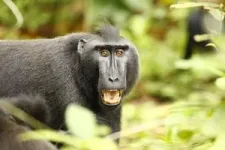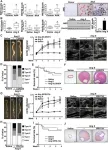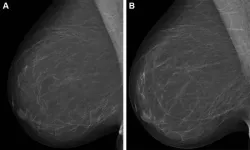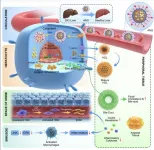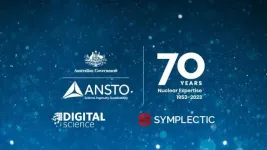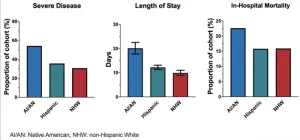(Press-News.org) CORVALLIS, Ore. – In northern Yellowstone National Park, saplings of quaking aspen, an ecologically important tree in the American West, are being broken by a historically large bison herd, affecting the comeback of aspen from decades of over-browsing by elk.
Findings of the research led by Luke Painter of Oregon State University were published today in Ecology and Evolution.
The study comes five years after Painter, who teaches ecology and conservation in the OSU College of Agricultural Sciences, published a paper in Ecosphere showing that wolf reintroduction in Yellowstone had been a catalyst for aspen recovery both outside and inside park boundaries.
“I’ve studied the response of aspen in northern Yellowstone to the reduction in elk after the wolves were brought back and found that during this time, bison increased and have begun to affect aspen,” Painter said. “Now we’re showing strong evidence of a previously unreported behavior of bison bulls breaking aspen saplings.”
The saplings were tall enough to escape most browsing by elk and thus likely to grow into trees, but bison broke them off at a low height, he said. Other saplings were killed when bison scraped off the bark with their horns.
Quaking aspen largely reproduces by root sprouts, a process known as suckering, and stands of aspen are often a single organism connected by the trees’ common root system. Fire stimulates aspen reproduction from both roots and seeds.
For much of the 20th century, Painter said, aspen sprouts were unable to grow into trees because they were eaten by elk during winter. But at the end of the century, when wolves were reintroduced and the numbers of other large predators such as grizzly bears and cougars increased, elk numbers in the northern part of Yellowstone went down, bringing relief to the aspen.
“Some young aspen began growing into saplings – young trees taller than 2 meters – which was an indication they were no longer being consumed by elk and were likely to grow into mature trees,” Painter said. “It was a trophic cascade that changed the Yellowstone ecosystem, creating conditions that could bring it closer to what it was historically, with more aspen, willow and beaver, which depend on these plants. But the tremendous increase in bison over the last two decades has added a new turn to the story.”
Bison have long been known to have strong effects on their environment, Painter said. Among those is removing and suppressing shrubs and trees by eating, trampling and breaking them – and as bison numbers have greatly risen in northern Yellowstone in the last two decades, their effects on plants have also increased.
In places where bison are present in large numbers, like Yellowstone’s iconic Lamar Valley, they are hindering some aspen stands from replacing their dying trees, he said.
The Yellowstone bison herd is divided into central and northern herds, and this study was in the range of the northern herd. The northern herd’s numbers were generally less than 1,000 until 2005 and then increased, for reasons that aren’t fully understood, to about 4,000 during the last decade, Painter said.
Painter and OSU College of Forestry collaborators Robert Beschta and William Ripple examined a random sampling of plots in 87 randomly selected aspen stands, and 18% of saplings had been broken. They may resprout from their base, but the sapling height has been lost and new sprouts are vulnerable to being eaten by bison or other herbivores, the researchers note.
Multiple lines of evidence support attributing the breakage to bison, Painter said.
“Most broken saplings were in areas of high bison density and low elk density, and they were broken in summer when elk wouldn’t have been foraging on them,” he said. “Plus we directly observed bison breaking aspen saplings. The purpose of the behavior doesn’t seem to be about accessing food, and we observed only bulls engaging in this behavior, so it may be related to displays of aggression.”
Painter noted that Yellowstone bison are managed under an agreement with the state of Montana that requires them to remain in or very near the park – those that stray are killed, captured or hazed back into the park, in large part because they can carry bacteria that cause brucellosis, a threat to Montana’s cattle industry.
Elk also carry brucellosis and have passed it to cattle, but the same restrictions are not applied to them. Thus, unlike other wildlife bison are not allowed to disperse to other areas as their numbers and density increase.
The conservation of bison in Yellowstone, whose numbers plummeted nationally from over-hunting in the 1800s, is a big success story, Painter noted – and so is the recovery of aspen and other deciduous woody plants that began when the park’s large predators made their comeback.
“Thus, one important conservation goal is affecting another important conservation goal,” he said. “Researchers are only beginning to understand how these conservation goals have overlapped and affected each other. We reported a piece of this complex puzzle, describing and quantifying one way that bison shape their habitat by suppressing trees.”
The study was supported in part by the National Science Foundation and the Ecosystem Restoration Research Fund of the Oregon State University Foundation.
END
Broken by bison, aspen saplings having a tough time in northern Yellowstone
2023-08-29
ELSE PRESS RELEASES FROM THIS DATE:
Partners from more than 100 countries collaborate as LOINC® issues 1,945 new concepts in semiannual release
2023-08-29
INDIANAPOLIS -- LOINC® from Regenstrief Institute is issuing its semiannual content update with 1,945 new concepts to help health systems, laboratories and other health organizations exchange medical data. The release contains newly created content based on requests submitted by stakeholders from more than 100 countries.
LOINC version 2.75 is available for download from the LOINC website and via the LOINC Terminology Service using HL7® FHIR®. The updated version includes new, edited and newly mapped concepts ...
New study will examine impact of lifestyle physical activity on cognition for older adults
2023-08-29
Jason Yang has been awarded nearly $400,000 from the National Institute on Aging to explore the role of lifestyle physical activity (light movements, walking) in cognition among insufficiently active older adults with higher risks for Alzheimer’s or related dementias. The exercise science assistant professor will use the two-year R21 grant to help determine if frequent and regular engagement in lifestyle physical activity over time may benefit cognitive function for this population.
A ...
More sleep could reduce impulsive behavior in children
2023-08-29
Sleep is a critical part of a child’s overall health, but it can also be an important factor in the way they behave.
According to a new study from the Youth Development Institute at University of Georgia, getting enough sleep can help children combat the effects of stressful environments.
“Stressful environments are shown to make adolescents seek immediate rewards rather than delayed rewards, but there are also adolescents who are in stressful environments who are not impulsive,” said lead author Linhao Zhang, a fourth-year doctoral student in UGA’s College of Family and Consumer Sciences. “We looked at what explains that link and what makes some people ...
New study sheds light on the role of Wnt/β-catenin signaling in abdominal aortic aneurysm
2023-08-29
Abdominal aortic aneurysm (AAA), a common degenerative vascular disease, particularly afflicts men over the age of 60, with up to 8% affected. Characterized by the abnormal dilation of the abdominal aorta, AAA risks a potentially fatal rupture. Despite increasing research efforts, effective pharmaceutical strategies to curb aneurysm growth remain elusive.
In a study published in the journal of Genes & Diseases, researchers from Sant Pau Hospital Research Institute and Biomedical Research Institute Sant Pau scrutinized the Wnt signaling pathway's deregulation in human abdominal aortic aneurysm (AAA). This ...
Combining AI models improves breast cancer risk assessment
2023-08-29
OAK BROOK, Ill. – Combining artificial intelligence (AI) systems for short- and long-term breast cancer risk results in an improved cancer risk assessment, according to a study published in Radiology, a journal of the Radiological Society of North America (RSNA).
Most breast cancer screening programs take a one-size-fits-all approach and follow the same protocols when it comes to determining a woman’s lifetime risk of developing breast cancer. Using mammography-based deep learning models may improve the accuracy of breast cancer risk assessment and can also lead to earlier ...
Anionic nanogel delivers effective anti-obesity drug to mouse livers
2023-08-29
An anti-obesity drug can be delivered selectively to the liver using a nanogel-based carrier, according to a study. Synthetic thyroid hormone mimics are promising treatments for metabolic diseases including metabolic dysfunction-associated steatohepatitis (MASH), high cholesterol, type 2 diabetes, and inflammatory liver disease; however, the molecules are not highly bioavailable or potent, which are necessary to see significant weight loss. S. Thayumanavan and colleagues designed a nanogel-based carrier with anionic moieties on the surface ...
Australia’s Nuclear Science and Technology Organisation (ANSTO) selects Symplectic Elements to enable comprehensive research management
2023-08-29
Digital Science, a technology company serving stakeholders across the research ecosystem, is pleased to announce that Australia’s Nuclear Science and Technology Organisation (ANSTO) has chosen Symplectic Elements from Digital Science’s flagship products to advance awareness of its world-class research.
ANSTO is the home to some of Australia’s most significant national infrastructure for research. Thousands of scientists from industry and academia benefit from gaining access to ANSTO’s ...
Molecule reduces inflammation in Alzheimer’s models
2023-08-29
Though drug developers have achieved some progress in treating Alzheimer’s disease with medicines that reduce amyloid-beta protein, other problems of the disease including inflammation, continue unchecked. In a new study, scientists at The Picower Institute for Learning and Memory at MIT describe a candidate drug that in human cell cultures and Alzheimer’s mouse models reduced inflammation and improved memory.
The target of the new “A11” molecule is a genetic transcription factor called PU.1. Prior research has shown that amid Alzheimer’s disease, PU.1 ...
Disproportionate impact of COVID-19 on American Indians
2023-08-29
A study of COVID-19 patients at a New Mexico hospital finds that the virus hit American Indian patients particularly hard—even though Native American patients had fewer other illnesses or conditions than non-native patients. Douglas Perkins and colleagues analyzed data on 475 patients with COVID-19 infections from the University of New Mexico Hospital. The sample was 30.7% Native American, 47% Hispanic, and 18.5% non-Hispanic White. At admission, Native American patients were younger, more likely to need ...
Novel SwRI-developed antenna array wins 2023 R&D 100 Award
2023-08-29
SAN ANTONIO — August 29, 2023 —Novel Southwest Research Institute-developed direction-finding technology has won a prestigious R&D 100 Award. R&D World Magazine has recognized SwRI’s Wideband Conformal Continuous-Slot Antenna Array as one of the 100 most significant innovations for 2023.
“Southwest Research Institute strives to uncover innovative solutions to complex problems,” said SwRI President and CEO Adam L. Hamilton, P.E. “I am very proud of the work SwRI does and pleased to know this technology, which will provide significant support to naval operations, has been recognized as one of the most important innovations ...

